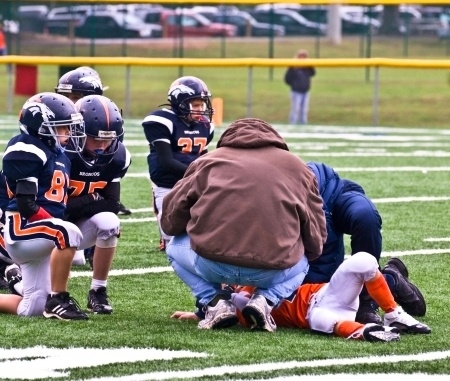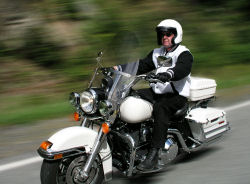Posts Tagged ‘“brain injuries”’
Attitudes are Changing on Allowing Children to Play Football
 American attitudes about football are changing–even though the sport remains as popular as ever, more adults are re-thinking whether their children should risk head injuries by playing football.
American attitudes about football are changing–even though the sport remains as popular as ever, more adults are re-thinking whether their children should risk head injuries by playing football.
A new study by HBO Real Sports and Marist College Institute for Public Opinion surveyed more than 1,200 adults by phone in July and reports most have learned about the connection between concussions suffered while playing football and long-term brain injury. As a result, one in three adults say they would be less likely to allow their own son to play if given the choice.
Ultimately, 85 percent would let their son play, another 13 percent would not and 2 percent are unsure (The study did not report on how respondents would feel about letting their daughters play).
Seven out of 10 Americans think the benefits of playing outweigh the risk for injury. Also, 74 percent of Americans think football is a good way to build character and boys should be encouraged to play.
One notable point is Americans seem to be placing trust in coaches, parents and even players themselves. Some 30 percent say they are less concerned about the risk of long-term brain injury because these individuals are more informed now and can take greater precautions.
Concussion Prevention for Student Athletes
The majority of states have passed concussion prevention laws for high school athletes. Massachusetts passed a law in 2010, which requires students, parents and coaches to receive annual training on recognizing and treating concussions. Student athletes who are suspected of having suffered a concussion must be removed from play and receive a doctor’s medical clearance before returning. Schools must also report concussions to the state Department of Public Health. The law covers high school and middle school athletes in football, soccer and all other sports.
Today, 49 states have concussion prevention laws. The only exception is Mississippi. Washington was the first state to pass such legislation. In May 2009, the state passed the “Lystedt Law,” named after 13-year-old Zackery Lystedt suffered permanent brain injury in 2006 while playing in a junior high school football game after suffering a concussion.
NFL Settlement
In August, after the survey was conducted, the National Football League (NFL) agreed to settle a class-action lawsuit brought by more than 4,500 players and their families.
The settlement, the result of court-ordered mediation, includes $5 million for men with Alzheimer’s disease, $4 million for those diagnosed after death with a brain condition called chronic traumatic encephalopathy and $3 million for players with dementia. The suit alleged the league concealed what it knew about concussions among its players and failed to protect them from repeated hits in the game. Plaintiffs included Hall of Famer Tony Dorsett, Jim McMahon and the family of former New England Patriots’ start Junior Seau, who committed suicide in 2012.
Youth Football Enrollment Still Increasing
Pop Warner is the nation’s largest youth football league, serving over 250,000 children between the ages of 5 and 15. In recent years, the league has implemented its own safety rules. One rule limits the amount of contact players have to one third of practice time. Another is “when in doubt, sit it out,” when a concussion is suspected.
But enrollment has not decreased as public awareness has grown about concussions and football, officials recently told CNN. Enrollment has increased one percent annually for the past ten years, through 2012.
Related:
Youth Football Takes Hard Hit… One-Third of Americans Less Likely to Allow Son To Play Football because of Head Injury Risk, HBO Real Sports/Marist Poll.
Read More
Helmets Protect Bicyclists of All Ages
 Bay State Bike Week is a good time to remember safety for Massachusetts bicyclists, motorists and all who travel the roads.
Bay State Bike Week is a good time to remember safety for Massachusetts bicyclists, motorists and all who travel the roads.
Motorists can commit to being vigilant in looking out for bicyclists this summer and slowing down. Bicyclists can ask whether they have taken all possible safety precautions.
These safety precautions must include bicycle helmets. Bicycle helmets are 85- to 88-percent effective in mitigating head and brain injuries in bike crashes, according to the National Highway Traffic and Safety Administration (NHTSA).
Nearly 70 percent of all fatal bike crashes involve head injuries, according to NHTSA figures. But only about 20 to 25 percent of all bicyclists wear helmets.
Individual states govern whether bicyclists must wear helmets. California was the first state to pass a bicycle helmet law in 1986. Twenty five years later, 21 other states have adopted laws aimed at cyclists under age 16. Fourteen states have no helmet laws, though the NHTSA recommends states adopt legislation.
Massachusetts requires helmets be worn by those 16 and younger while operating a bicycle or traveling on one as a passenger. Helmets must be approved by the Consumer Product Safety Commission.
Adults in Massachusetts and other states should not wait for the law to require them to wear helmets. In 2006, 773 bicyclists were killed and another 44,000 were injured in traffic crashes across the country. Children 14 and younger accounted for 98 of those fatalities, making this one of the most frequent causes of injury related death for young children. But the other 675 bicyclists were older and many of them could have also benefited from the protection of a bicycle helmet.
Click here for more information about bicycle helmet laws from the National Highway Traffic Safety Administration.
Read More
Motorcycle Safety Awareness Month Time to Consider Helmets and Safety Gear
 Motorcycling is a fun way to pass a sunny afternoon, but one that requires taking some safety precautions. Motorcyclist deaths have been rising in recent years – more than doubling in 2008 from the record low in 1977. The federal government estimates that per mile traveled, the number of deaths on motorcycles in 2007 was 37 times the number of people in cars.
Motorcycling is a fun way to pass a sunny afternoon, but one that requires taking some safety precautions. Motorcyclist deaths have been rising in recent years – more than doubling in 2008 from the record low in 1977. The federal government estimates that per mile traveled, the number of deaths on motorcycles in 2007 was 37 times the number of people in cars.
These figures mean it is important to dress to protect yourself in case of motorcycle accidents.
Helmets: Helmets are especially important. They are 37 percent effective in preventing motorcycle deaths and 67 percent effective in preventing brain injuries, according to National Highway Traffic Safety Administration (NHTSA) figures.
Twenty states and Washington D.C. require all riders to wear motorcycle helmets, including Massachusetts and Vermont. New Hampshire has no motorcycle helmet law. Rhode Island, Maine and Connecticut have laws that require younger operators to wear helmets.
If you are looking for a helmet, look for one that meets Department of Transportation (DOT) standards. All adult-sized helmets have been required to meet these standards since 1980. Helmets may be additionally approved by the Snell Memorial Foundation, but this testing standard is voluntary for helmet manufacturers.
There are several types of helmets available on the market, but full-face helmets provide the most protection in case of motorcycle accidents. Other types of helmets include open-face helmets and “shorty” half-helmets. If you choose an open-face helmet, make sure to buy a pair of safety eyeglasses. Shorty half-helmets are generally not recommended because they leave a large area of your face and head exposed in motorcycle accidents.
Lastly, it’s important to make sure you choose the right size helmet. If a motorcycle dealer isn’t ordering your helmet for you, measure the largest part of your head with a tape measure and call the manufacturer. Most helmets are sold in small, medium, large or extra large, so tell the customer service representative your measurement and ask them what size helmet you need.
Clothing: When it comes to jackets and pants, choose the most sturdy materials for the most protection. Leather is considered the best, but denim and corduroy also work. If you worry about overheating, choose pants and vests with zippered vents. And remember, always wear gloves to protect your hands in case of a motorcycle accident or fall on the roadway.
Reflective Clothing: The more visible you are to other drivers, the better your chances are for avoiding a motorcycle accident. Wear brightly colored jackets and pants or reflective material that can be seen at all hours day or night.
Eye Protection: Many motorcyclists choose helmets with an approved shield covering their eyes. Others use separate safety goggles or shatterproof glasses. Make sure your eye protection is clean and unscratched each time before you start riding. If you use a tinted lens for the bright sun, be prepared. Take a clear lens as well in case your ride goes into the night.
Click here for more on state motorcycle helmet laws.
Click here for more information about motorcycle helmets and other safety gear from the Motorcycle Safety Foundation.
Read More

